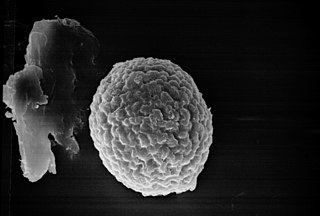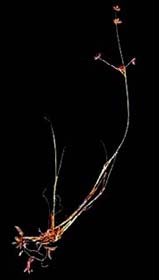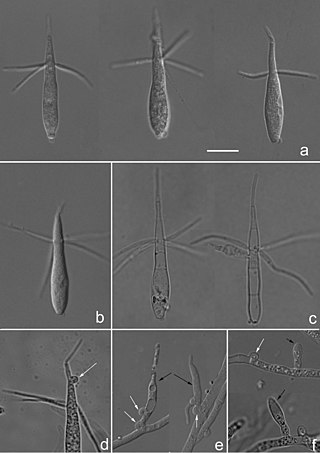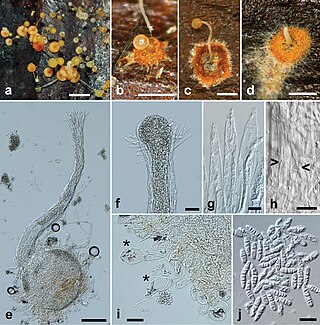
Pucciniomycotina is a subdivision of fungus within the division Basidiomycota. The subdivision contains 10 classes, 21 orders, and 38 families. Over 8400 species of Pucciniomycotina have been described - more than 8% of all described fungi. The subdivision is considered a sister group to Ustilaginomycotina and Agaricomycotina, which may share the basal lineage of Basidiomycota, although this is uncertain due to low support for placement between the three groups. The group was known as Urediniomycetes until 2006, when it was elevated from a class to a subdivision and named after the largest order in the group, Pucciniales.

The Auriculariales are an order of fungi in the class Agaricomycetes. Species within the order were formerly referred to the "heterobasidiomycetes" or "jelly fungi", since many have gelatinous basidiocarps that produce spores on septate basidia. Around 200 species are known worldwide, placed in six or more families, though the status of these families is currently uncertain. All species in the Auriculariales are believed to be saprotrophic, most growing on dead wood. Fruit bodies of several Auricularia species are cultivated for food on a commercial scale, especially in China.

The Tilletiales are an order of smut fungi in the class Exobasidiomycetes. It is a monotypic order, consisting of a single family, the Tilletiaceae, which contains seven genera. The roughly 150 species in the Tilletiales all infect hosts of the grass family, except for species of Erratomyces, which occur on legumes.

Entorrhizomycetes is the sole class in the phylum Entorrhizomycota within the Fungi subkingdom Dikarya along with Basidiomycota and Ascomycota. It contains three genera and is a small group of teliosporic root parasites that form galls on plants in the Juncaceae (rush) and Cyperaceae (sedge) families. Prior to 2015 this phylum was placed under the subdivision Ustilaginomycotina. A 2015 study did a "comprehensive five-gene analyses" of Entorrhiza and concluded that the former class Entorrhizomycetes is possibly either a close sister group to the rest of Dikarya or Basidiomycota.

The Classiculomycetes are a class of fungi in the Pucciniomycotina subdivision of the Basidiomycota. The class contains a single order, the Classiculales, which in turn contains the single family Classiculaceae. The family contains two monotypic genera.
Atractogloeaceae is a fungal family in the order Atractiellales. The family contains the single genus Atractogloea, which in turn contains the single species Atractogloea stillata, found in the USA.
Mycogelidium is a genus of fungi in the order Capnodiales. It contains the single species Mycogelidium sinense, described from China. The species was originally misinterpreted as a basidiomycete in the order Atractiellales and placed in its own family, the Mycogelidiaceae. Septate conidiophores were mistaken for auricularioid basidia. The species is now considered to belong within the anamorphic Capnodiales.
Atractiella is a genus of fungi in the family Hoehnelomycetaceae. The widespread genus contains seven species. Basidiocarps are minute and stilboid (pin-shaped) Microscopically they produce auricularioid basidia. Molecular research, based on cladistic analysis of DNA sequences, has shown that the genus is monophyletic.
Basidiopycnis is a fungal genus in the family Hoehnelomycetaceae. The genus is monotypic, containing the single species Basidiopycnis hyalina. The species forms minute pycnidial basidiocarps in bark beetle tunnels. Teleomorphs produce auricularioid basidia, whilst anamorphs produce asexual conidia. Basidiopycnis hyalina was described from Germany and is also known from Italy and Switzerland. Anamorphic fruit bodies collected in Canada were given the name Basidiopycnides albertensis, but are currently considered conspecific with the European species.
Proceropycnis is a genus of fungi in the family Hoehnelomycetaceae. The genus is known from Spain, North America, and east Asia.

The Heterogastridiales are an order of fungi in the class Microbotryomycetes. The order contains a single family, the Heterogastridiaceae, which currently contains five genera. Some species in the order are currently known only from their yeast states. Those producing hyphal states have auricularioid basidia and are parasitic on other fungi. Basidiocarps, when present, are minute and variously stilboid (pin-shaped), pustular, or pycnidioid (flask-shaped). Molecular research, based on cladistic analysis of DNA sequences, has shown that the order is a monophyletic (natural) group, though the type and only species of Krieglsteinera has not yet been sequenced and may belong elsewhere.
The Agaricostilbales are an order of fungi in the class Agaricostilbomycetes. The order consists of six families and 15 genera.
Colacogloea is a genus of fungi belonging to the class Microbotryomycetes. Most species in the genus are known only from their yeast states. Where known, basidiocarps have auricularioid basidia and occur as parasites on or in the fruit bodies of other fungi.

The Platygloeales are an order of fungi in the class Pucciniomycetes. Species in the order have auricularioid basidia and are typically plant parasites on mosses, ferns, and angiosperms, though Platygloea species appear to be saprotrophic.
The Spiculogloeomycetes are a class of fungi in the subdivision Pucciniomycotina of the Basidiomycota. The class consists of a single order, the Spiculogloeales, together with an additional, unassigned genus, Meniscomyces. Many species are currently known only from their yeast states. Species in the genus Spiculogloea form hyphal states that produce auricularioid basidia and are parasitic on other fungi.
The Platygloeaceae are a family of fungi in the class Pucciniomycetes. Species in the family have auricularioid basidia and are typically plant parasites on angiosperms, though Platygloea species appear to be saprotrophic.

The Eocronartiaceae are a family of fungi in the class Pucciniomycetes. Species in the family have auricularioid basidia and are typically plant parasites on ferns and mosses.
Platygloea is a genus of fungi belonging to the class Pucciniomycetes. Basidiocarps of the type species are disc-shaped, gelatinous, and occur on dead wood, probably as a saprotroph. Microscopically, all species of Platygloea sensu lato have auricularioid basidia. Currently the genus contains a heterogeneous mix of auricularioid fungi not yet accommodated in other genera.
Occultifur is a genus of fungi in the family Cystobasidiaceae. Species are parasites of other fungi and, microscopically, have auricularioid basidia and basidiospores that germinate by yeast cells. Several species are currently only known from their yeast states. The genus is distributed worldwide.
Hyalopycnis is a genus of fungi in the subdivision Pucciniomycotina. The genus is currently monotypic, comprising the single species Hyalopycnis hyalina. This was originally described as a minute, pycnidial (flask-shaped), anamorphic fungus, later found to be basidiomycetous. Later still, a teleomorphic state was found, producing auricularioid basidia and basidiospores that are tetraradiate. This latter state was given the name Heterogastridium pycnidioideum, but, following changes to the International Code of Nomenclature for algae, fungi, and plants, the practice of giving different names to teleomorph and anamorph forms of the same fungus was discontinued, meaning that Heterogastridium became a synonym of the earlier name Hyalopycnis. The species was described from Europe and is also known from North America and Japan, growing on decaying fungal fruit bodies or vegetable matter.






